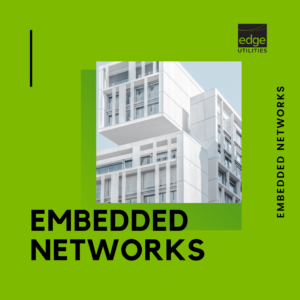What are embedded networks?
Embedded networks are private electricity networks connected through a parent connection to the National Electricity Market (NEM). The private network supplies end users (customers) that are “behind the meter”. They are connected to the private distribution or transmission system.
Embedded networks may be found in sites such as:
- Industrial Estates
- Shopping Centres
- Retirement Villages
- Gated Communities
- Caravan Parks
- Large buildings including, residential apartments or offices.
How do embedded networks work?
The network behind the meter needs to be designed and built to the appropriate Australian Standard.
Embedded networks operate in a highly regulated landscape and the developer or network owner must understand these requirements.
The owner, operator or controller of the private network will need the necessary permission to supply and sell electricity. These permissions may change depending on what state the network is in.
Embedded network operators operate as a Network Service Provider (NSP) and must obtain an exemption from the requirement to register as an NSP from the Australian Energy Regulator (AER).
An Embedded Network Manager (ENM) should be appointed:
- if there are 30 or more customers in the embedded network.
- if a customer within an embedded network goes on-market.
An ENM is accredited by the Australian Energy Market Operator (AEMO). Their role is to transfer customers on or off market via AEMO’s wholesale market systems (MSATS).
The embedded network can be connected to the NEM via a primary connection that will be registered as a parent / child relationship.
The embedded network operator will be billed via their retailer of choice at the connection point.
How do customers in an embedded network buy their energy?
Embedded Network Operators can be appointed to manage procurement and invoicing services for an embedded network.
They buy from the market (through a market retailer) and sell directly to the embedded network customers. These embedded network customers are “off-market”.
Customers in an embedded network have the Power of Choice. This means they may choose to purchase their energy from a retailer other than the embedded network operator and therefore go “on-market”.
A customer may be required to be in MSATS if it is on-market. As the embedded network operator provides embedded network customers with network services, an on-market embedded network customer will still receive an invoice from the embedded network operator for network costs.
Why do we have embedded networks / what are the benefits?
Embedded networks allow a site of customers to receive energy through one “gate” meter, which allows them to purchase energy from the market in bulk.
Bulk large customer electricity deals should attract significantly lower rates than a stand-alone small customer deal.
Property developers and embedded network operators benefit from embedded networks by sharing in the savings achieved through the bulk energy deals at the gate.
Why have embedded networks received a bad name / what are the disadvantages?
Customers in embedded networks find themselves paying more than what they could otherwise achieve. Either through another (market) retailer, or another embedded network operator. Whilst Power of Choice technically allows these customers to go to a market retailer to purchase their energy, doing so can be challenging. Many retailers find it difficult to provide a (small) embedded network customer an energy only deal. The customer also faces the problem of then receiving two invoices for their electricity.

